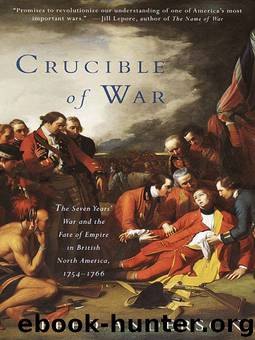Crucible of War: The Seven Years' War and the Fate of Empire in British North America, 1754-1766 by Fred Anderson

Author:Fred Anderson [Anderson, Fred]
Language: eng
Format: mobi, epub, azw3
Tags: History, History.war
ISBN: 9780375706363
Google: jyuMqKzZJnUC
Publisher: Vintage Books
Published: 2000-01-02T00:00:00+00:00
Plan of a turret at Fort Loudoun, 1759. Captain Paul Demeré enclosed these sketches of features of Fort Loudoun in a letter to William Henry Lyttelton of February 27, 1759. At left is the flagstaff, some fifty feet tall and supported by a pyramidal base. On the right is the plan of a three-story hexagonal turret, or tower, of the sort sometimes erected at the points of bastions, to give a better view of the surrounding area. A sturdy structure constructed of logs, it was capable of mounting swivels (light cannon) to fire through the portholes on the second floor, and had loopholes for muskets on the first and third levels. The footprint of the tower, with eighteen-foot exterior faces, a thirty-six-foot diameter, and a circular center stair, appears at bottom right. The sketch immediately above it shows the appearance of one face, some twenty feet tall, with a palisade and fraising to protect the rooftop firing platform. Courtesy of the William L. Clements Library at the University of Michigan.
A good deal of quite deliberate killing followed the surrender. Between casualties sustained in the initial firing and the butchery that ensued, a total of twenty-five people lost their lives—three women plus a number of soldiers equal to the hostages massacred at Fort Prince George six months before. All the officers save one—a South Carolina provincial and former Scots merchant, Captain John Stuart, who had become a friend of Little Carpenter—were killed, but only Captain Demeré, who was scalped while alive and then forced to dance until he died, seems to have been ritually tortured. The common soldiers were stripped, beaten, and driven off into captivity; their wives and children were evidently treated gently. Captain Stuart was allowed to accompany Little Carpenter on a peace mission to Virginia. The remainder of the captives, about two hundred in all, remained in the Overhill Towns until the end of the war.13
Following Montgomery’s flight and Fort Loudoun’s fall, Cherokee leaders and the South Carolina authorities warily observed a six-month truce. Although Fort Prince George was nearly as vulnerable as Fort Loudoun had been, the Indians did not subject it to close siege, and as a goodwill gesture even allowed a limited amount of supplies to be brought in. Meanwhile, the Cherokees talked: to the French, who sent small symbolic gifts from Fort Toulouse, but no ammunition; to the Creeks, who continued to refuse a direct alliance while they explored ways to increase their standing at Cherokee expense; to the Virginians, who threatened invasion and sent gifts to support Little Carpenter; to Lyttelton’s successor, Lieutenant Governor William Bull, who advocated peace and tried desperately to persuade men to enlist in the South Carolina provincial regiment. Everyone but the Cherokees played for time. And time—as the nativist leaders, whose prestige and morale were at the zenith, were too slow to realize—was the one element that favored the Cherokees least.
The winter of 1761 weakened the Indians, who suffered by the great depth of snow, scarcity of ammunition, shortages of food brought on by the loss of the Lower Towns’ harvest, and disease.
Download
Crucible of War: The Seven Years' War and the Fate of Empire in British North America, 1754-1766 by Fred Anderson.epub
Crucible of War: The Seven Years' War and the Fate of Empire in British North America, 1754-1766 by Fred Anderson.azw3
This site does not store any files on its server. We only index and link to content provided by other sites. Please contact the content providers to delete copyright contents if any and email us, we'll remove relevant links or contents immediately.
| Africa | Americas |
| Arctic & Antarctica | Asia |
| Australia & Oceania | Europe |
| Middle East | Russia |
| United States | World |
| Ancient Civilizations | Military |
| Historical Study & Educational Resources |
Making Haste From Babylon(786)
New York Burning by Jill Lepore(710)
Bunker Hill by Nathaniel Philbrick(678)
An Inquiry Into the Nature and Causes of the Wealth of Nations by Adam Smith(665)
Braddock's March by Thomas E. Crocker(661)
Commonwealth Caribbean Criminal Practice and Procedure by Dana S. Seetahal(603)
The City-State of Boston by Mark Peterson(591)
Infamous Scribblers by Eric Burns(558)
America's Revolutionary Mind by C. Bradley Thompson;(552)
The Barbarous Years by Bernard Bailyn(550)
John Adams Under Fire: The Founding Father's Fight for Justice in the Boston Massacre Murder Trial by Dan Abrams(538)
The Wealth of Nations Books I-III by Adam Smith(536)
Bunker Hill: A City, a Siege, a Revolution by Nathaniel Philbrick(526)
A Land So Strange: The Epic Journey of Cabeza de Vaca by Andre Resendez(525)
American Slavery: A Very Short Introduction (Very Short Introductions) by Heather Andrea Williams(510)
White Slavery In Colonial America: And Other Documented Facts Supressed from the Public Know! by Dee Masterson(505)
The First American by H.W. Brands(501)
The Barbarous Years: The Peopling of British North America: The Conflict of Civilizations, 1600-1675 by Bernard Bailyn(482)
George Washington by John Rhodehamel(476)
